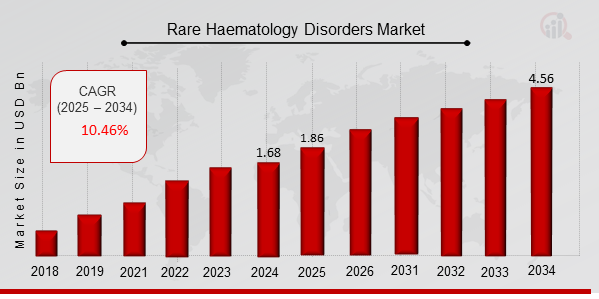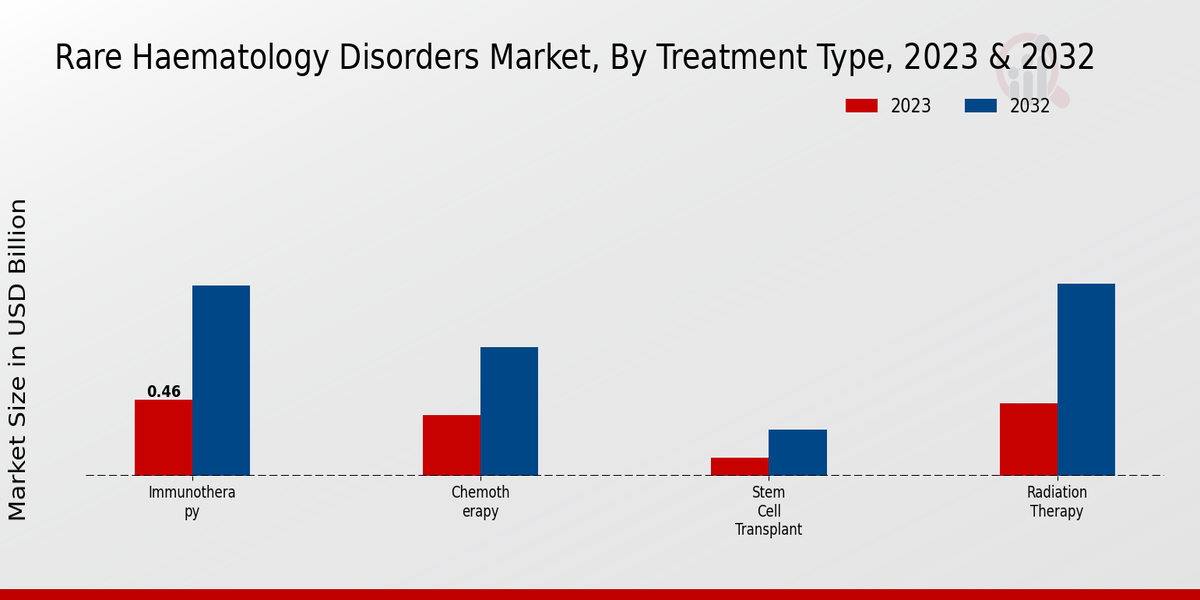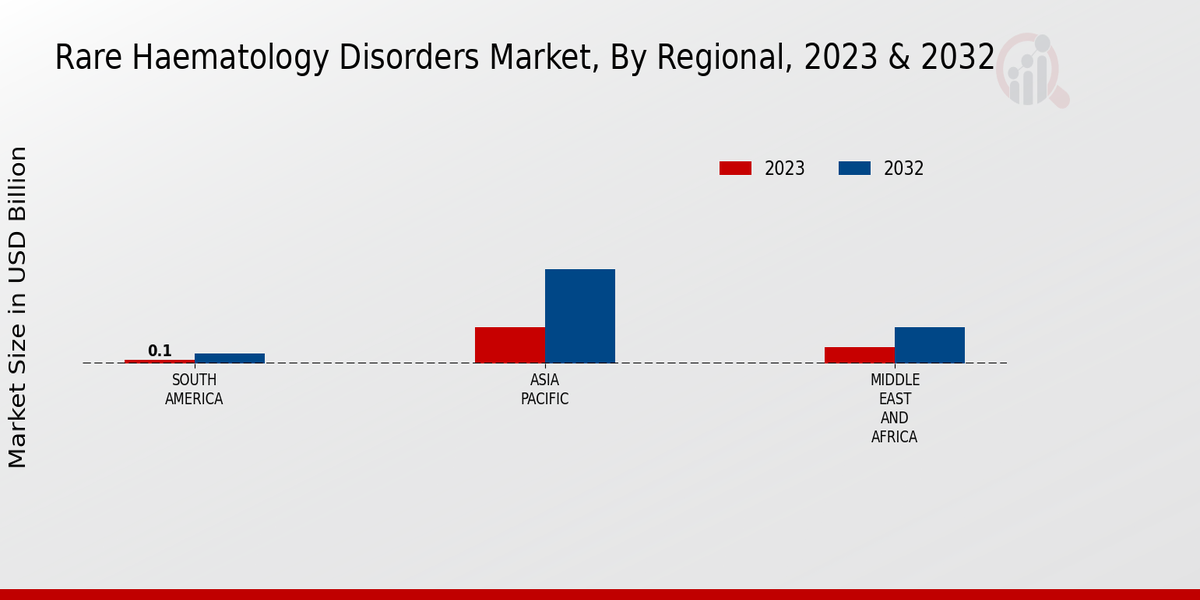Rare Haematology Disorders Market Overview
As per MRFR analysis, the Rare Haematology Disorders Market Size was estimated at 1.68 (USD Billion) in 2024. The Rare Haematology Disorders Market Industry is expected to grow from 1.86 (USD Billion) in 2025 to 4.56 (USD Billion) till 2034, at a CAGR (growth rate) is expected to be around 10.46% during the forecast period (2025 - 2034).
Key Rare Haematology Disorders Market Trends Highlighted
Key market drivers in the rare hematology disorders market include the rising prevalence of hematological disorders, increasing awareness of rare diseases, and growing government support for research and development.
Technological advancements, such as the development of gene editing therapies and targeted drugs, are also driving market growth. Opportunities for market capture lie in collaborations between pharmaceutical companies and research institutions, the development of personalized treatments, and the expansion into emerging markets.
Recent market trends include the increasing adoption of precision medicine, the emergence of biosimilars, and the growing focus on patient-centric care. The market is expected to witness significant growth in the coming years, driven by these factors and the increasing demand for innovative therapies.

Source: Primary Research, Secondary Research, MRFR Database and Analyst Review
Rare Haematology Disorders Market Drivers
Increasing Prevalence of Rare Haematological Disorders
A major factor driving the global rare hematology disorders market is the increase in the prevalence of rare hematological disorders. There has been a growing incidence of these disorders due to the interactions between genetic mutations, environmental triggers, and lifestyle choices.
The prevalence of rare hematological disorders is expected to continue increasing as the population ages. Since older adults are generally more susceptible to these illnesses, the growing incidence of these disorders creates an important unmet medical need.
Technological Advancements in Diagnosis and Treatment
Besides the efforts of market players and authorities, the growth of the global rare hematology disorders market is influenced by technological advancements related to the diagnosis and treatment of such disorders. Some new diagnostic tools make it possible to identify rare hematological disorders quicker and with a higher level of accuracy.
For example, next-generation sequencing can be used to "identify new parameters and algorithms that can accurately diagnose rare disorders in the early stages".
Aliosman et al., however, note that this technology also has some limitations, which should be taken into account. Furthermore, the development of new therapies also contributes to the increased efficiency of the treatments associated with rare hematological disorders.
For instance, the author writes that "targeted therapies and immunotherapies are newer treatment modalities in rare hematological malignancies". These circumstances imply that technological advancements also help the market grow, and these technologies are likely to be further improved in the years to come.
Growing Demand for Orphan Drugs
Another major driver of the global rare hematology disorders market is the growing demand for orphan drugs. Orphan drugs are drugs developed to treat rare diseases, and they are typically costly.
However, as more patients with rare hematological disorders learn about the options available for treatment, demand for orphan drugs is increasing, and governments are offering more incentives to pharmaceutical companies for developing orphan drugs, driving the growth of the market.
The demand for orphan drugs is expected to continue to drive market growth in the coming years.
Rare Haematology Disorders Market Segment Insights
Rare Haematology Disorders Market Treatment Type Insights
The Global Rare Haematology Disorders Market reflects a diverse and evolving treatment landscape across its treatment types.
Among these types, Targeted Therapy emerged as a significant player, holding a value of 0.4 USD Billion in 2023 and projected to grow to 0.97 USD Billion by 2032. This treatment modality was gaining traction due to its precision in targeting specific genetic mutations associated with rare hematological disorders, thereby promising improved patient outcomes with potentially fewer side effects.
Immunotherapy, valued at 0.25 USD Billion in 2023 and expected to reach 0.6 USD Billion by 2032, was also critical, leveraging the body's immune system to combat rare blood-related diseases. This sector benefits from ongoing research and advancements that expand its applications, contributing to a broader acceptance and integration into treatment protocols.
Chemotherapy, with a valuation of 0.3 USD Billion in 2023 and projected to attain 0.8 USD Billion by 2032, remained a cornerstone in the management of many rare hematologic conditions. Despite facing competition from newer therapies, its role in disease management is fundamental, particularly in acute scenarios where rapid intervention is necessary.
Stem Cell Transplant, holding a market value of 0.23 USD Billion in 2023 with expectations to grow to 0.56 USD Billion by 2032, played a crucial role, especially in conditions such as aplastic anemia and certain leukemias, where it has been a lifesaving treatment option for many patients.
Meanwhile, Radiation Therapy, although comparatively smaller, valued at 0.2 USD Billion in 2023 and projected to reach 0.46 USD Billion by 2032, remained relevant due to its utility in specific treatment settings, particularly for localized disease control in rare hematological malignancies.
The market's growth in these treatment types is driven by advancements in medical technology, the increasing prevalence of rare hematological disorders, and a growing focus on personalized medicine.
Furthermore, healthcare policies aimed at increasing patient access to treatments and initiatives promoting research into rare diseases present substantial opportunities in the Global Rare Haematology Disorders Market.
Notably, while Targeted Therapy and Immunotherapy are projected to dominate due to their innovative approaches and rising acceptance, traditional modalities like Chemotherapy and Stem Cell Transplant will continue to play significant roles in comprehensive treatment plans.
Analyzing the Global Rare Haematology Disorders Market data reveals a robust segmentation landscape where these treatment types cater to distinct patient needs and illustrate a pathway toward enhanced therapeutic strategies for rare blood disorders.

Source: Primary Research, Secondary Research, MRFR Database and Analyst Review
Rare Haematology Disorders Market Patient Age Insights
The Global Rare Haematology Disorders Market represents a critical area of healthcare that reflects significant growth trends, particularly concerning the Patient Age segment. This segment consists of both Pediatric and Adult populations, each playing a vital role in the overall market dynamics.
Pediatric patients often require specialized therapies and treatments, leading to a rising demand for tailored healthcare solutions, which significantly contributes to the revenue stream.
Conversely, the Adult segment dominates due to a higher prevalence of rare hematology disorders, thereby driving extensive research and development efforts within the industry.
The increasing incidence of these disorders among adults is a crucial growth driver, presenting opportunities for medical advancements and enhanced treatment options.
The Global Rare Haematology Disorders Market statistics underscore that this segmentation not only sheds light on the different patient needs but also acts as a basis for targeted investments in healthcare solutions.
Continuous innovations and regulatory advancements are shaping the landscape, thereby enhancing the overall market growth while addressing the unique needs of both age groups.
Rare Haematology Disorders Market Disease Severity Insights
Within the context of Disease Severity, the market is divided into categories of Low-Risk, Intermediate-Risk, and High-Risk disorders, each playing a critical role in the overall dynamics of the industry.
Low-risk disorders, while generally manageable, still require careful monitoring and treatment, ensuring a steady interest from healthcare providers.
Intermediate-risk conditions often necessitate more complex therapeutic interventions, making them crucial for growth trajectories within the market. High-risk disorders, known for their complications and urgent treatment needs, dominate market attention due to the significant investment in advanced therapies and innovative treatment options.
These categories not only reflect the diverse nature of Rare hematology disorders but also underscore the growing emphasis on targeted therapies and novel treatment pathways, ultimately shaping the Global Rare hematology disorders Market revenue and market growth.
As the industry evolves, understanding the intricacies of disease severity classification will remain vital for stakeholders aiming to develop and deliver effective solutions tailored to patient needs
Rare Haematology Disorders Market Regional Insights
The Global Rare Haematology Disorders Market is witnessing a robust growth trajectory across various regional segments. In 2023, North America held a majority share with a valuation of 0.65 USD Billion, expected to grow to 1.57 USD Billion by 2032, highlighting its dominance in the market driven by advanced healthcare infrastructure and significant research investments.
Europe followed closely with a valuation of 0.45 USD Billion in 2023, projected to reach 1.05 USD Billion by 2032, reflecting a strong regulatory framework and increased awareness among healthcare professionals.
South America and Asia Pacific were at relatively lower valuations of 0.1 USD Billion and 0.15 USD Billion in 2023, respectively, but each shows potential for growth, with South America expected to rise to 0.25 USD Billion and Asia Pacific to 0.36 USD Billion by 2032.
The Middle East and Africa remained the smallest segment with a market value of 0.03 USD Billion in 2023 and is forecasted to grow to 0.06 USD Billion by 2032, attributed to limited healthcare resources and infrastructure challenges.
These insights into the Global Rare Haematology Disorders Market segmentation highlighted significant regional variations influenced by factors such as healthcare access, research capabilities, and regional disease prevalence.

Source: Primary Research, Secondary Research, MRFR Database and Analyst Review
Rare Haematology Disorders Market Key Players And Competitive Insights
Major players in the Rare Haematology Disorders Market are continuously focusing on developing and commercializing innovative therapies to address the unmet medical needs of patients with rare hematology disorders.
Leading Rare Haematology Disorders Market players are also investing in research and development to expand their product portfolios and strengthen their market positions. The Rare hematology disorders Market is expected to witness significant growth in the coming years, driven by the increasing prevalence of rare hematology disorders and the growing demand for effective treatments.
The competitive landscape of the Rare Haematology Disorders Market is expected to remain highly competitive, with major players vying for market share through product innovation, acquisitions, and partnerships.
A leading player in the Rare Haematology Disorders Market, Roche is focused on providing innovative treatments for patients with rare hematological diseases.
The company has a strong portfolio of products for the treatment of hematological malignancies, including multiple myeloma, chronic lymphocytic leukemia, and acute myeloid leukemia. Roche is also investing in research and development to expand its product portfolio and strengthen its market position.
The company recently acquired Genentech, which has a strong pipeline of innovative therapies for the treatment of rare hematological diseases.
A competitor in the Rare Haematology Disorders Market, Novartis, is also focused on providing innovative treatments for patients with rare hematological diseases.
The company has a strong portfolio of products for the treatment of hematological malignancies, including chronic myeloid leukemia, acute lymphoblastic leukemia, and mantle cell lymphoma.
Novartis is also investing in research and development to expand its product portfolio and strengthen its market position. The company recently acquired AveXis, which has a strong pipeline of gene therapies for the treatment of rare hematological diseases.
Key Companies in the Rare Haematology Disorders Market Include
Bristol-Myers Squibb Company
Sanofi S.A.
Merck Co., Inc.
AbbVie Inc.
Alexion Pharmaceuticals
Roche Holding AG
Pfizer Inc.
Gilead Sciences, Inc.
BioMarin Pharmaceutical Inc.
Celgene Corporation
Novartis AG
Janssen Pharmaceuticals, Inc.
Incyte Corporation
Amgen Inc.
Rare Haematology Disorders Market Developments
The Rare Haematology Disorders Market is experiencing substantial growth, driven by the increasing prevalence of rare hematological disorders and advancements in diagnostics and treatment options.
Key players in the market include Novartis, Celgene, and Roche. Recent developments include the FDA approval of Novartis' Kymriah for the treatment of relapsed or refractory B-cell acute lymphoblastic leukemia and the acquisition of Celgene by Bristol-Myers Squibb.
Market growth is expected to continue in the coming years, with a focus on personalized medicine and the development of novel therapies.
Rare Haematology Disorders Market Segmentation Insights
Rare Haematology Disorders Market Treatment Type Outlook
- Targeted Therapy
- Immunotherapy
- Chemotherapy
- Stem Cell Transplant
- Radiation Therapy
Rare Haematology Disorders Market Patient Age Outlook
Rare Haematology Disorders Market Disease Severity Outlook
- Low-Risk
- Intermediate-Risk
- High-Risk
Rare Haematology Disorders Market Regional Outlook
- North America
- Europe
- South America
- Asia Pacific
- Middle East and Africa
|
Report Attribute/Metric
|
Details
|
|
Market Size 2024
|
1.68 (USD Billion)
|
|
Market Size 2025
|
1.86 (USD Billion)
|
|
Market Size 2034
|
4.56 (USD Billion)
|
|
Compound Annual Growth Rate (CAGR)
|
10.46 % (2025 - 2034)
|
|
Report Coverage
|
Revenue Forecast, Competitive Landscape, Growth Factors, and Trends
|
|
Base Year
|
2024
|
|
Market Forecast Period
|
2025 - 2034
|
|
Historical Data
|
2020 - 2024
|
|
Market Forecast Units
|
USD Billion
|
|
Key Companies Profiled
|
Bristol-Myers Squibb Company, Sanofi S.A., Merck Co., Inc., AbbVie Inc., Alexion Pharmaceuticals, Roche Holding AG, Pfizer Inc., Gilead Sciences, Inc., BioMarin Pharmaceutical Inc., Celgene Corporation, Novartis AG, Janssen Pharmaceuticals, Inc., Incyte Corporation, Amgen Inc.
|
|
Segments Covered
|
Treatment Type, Patient Age, Disease Severity, Regional
|
|
Key Market Opportunities
|
1 Rising Prevalence of Rare Haematological Disorders
2 Advancements in Diagnostics and Treatments
3 Growing Government Support and Funding
4 Increasing Awareness and Education
5 Expansion into Emerging Markets
|
|
Key Market Dynamics
|
Rising prevalence of rare hematological disorders Advancements in diagnostic techniques Increasing investment in research and development Growing awareness of rare hematological disorders Government initiatives and support organizations.
|
|
Countries Covered
|
North America, Europe, APAC, South America, MEA
|
Frequently Asked Questions (FAQ) :
The Global Rare Haematology Disorders Market is expected to be valued at 3.39 USD Billion by 2032.
The expected CAGR for the Global Rare Haematology Disorders Market is 10.46% from 2025 to 2034.
North America is projected to have the highest market value, reaching 1.57 USD Billion by 2032.
Immunotherapy is expected to reach a market value of 0.6 USD Billion by 2032.
The major players include companies such as Bristol-Myers Squibb Company, Sanofi S.A., and Merck Co., Inc.
The Targeted Therapy segment was valued at 0.4 USD Billion in 2023.
The Middle East and Africa region is expected to see the lowest market value of 0.06 USD Billion by 2032.
The market value for Stem Cell Transplant is expected to reach 0.56 USD Billion by 2032.
Chemotherapy is projected to have a market value of 0.8 USD Billion by 2032.
South America is expected to grow to a market value of 0.25 USD Billion by 2032.

















